Componente: conceito
Mantenha tudo organizado com as coleções
Salve e categorize o conteúdo com base nas suas preferências.
Elemento: conceito / informações
| Namespace |
http://schemas.google.com/dspl/2010 |
| Anotações |
Informações textuais, como o nome e a descrição do
conceito. |
| Diagrama |
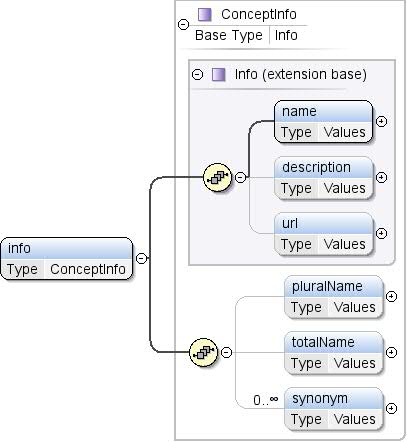 |
| Tipo |
ConceptInfo |
| Hierarquia de tipos |
|
| Propriedades |
|
| Modelo |
nome , descrição{0,1} , url{0,1} , pluralName{0,1} , totalName{0,1} , sinônimo* |
| Filhos |
description, name, pluralName,
sinônimo, totalName, url |
| Instância |
<info>
<name>{1,1}</name>
<description>{0,1}</description>
<url>{0,1}</url>
</info>
|
| Origem |
<xs:element name="info" type="ConceptInfo">
<xs:annotation>
<xs:documentation>Textual information, such as the name and description of
the concept.</xs:documentation>
</xs:annotation>
</xs:element>
|
Elemento: conceito / tópico
| Namespace |
http://schemas.google.com/dspl/2010 |
| Anotações |
Um tema associado ao conceito. |
| Diagrama |
 |
| Propriedades |
| content: |
complexo |
| minOcurs: |
0 |
| maxOccurs: |
ilimitada |
|
| Atributos |
| QName |
Tipo |
Fixo |
Padrão |
Usar |
Nota |
| ref |
xs:QName |
|
|
opcional |
O identificador exclusivo do tópico a que este conceito é
associados. O tópico mencionado pode ser definido no mesmo
externo ou externamente, ou seja, em outro conjunto de dados. Uma referência a um
tópico externo deve estar no formato
"prefix:other_topic_id", em que "prefix" é
Prefixo usado para o namespace do conjunto de dados externo (consulte XML
namespaces). |
|
| Origem |
<xs:element name="topic" minOccurs="0" maxOccurs="unbounded">
<xs:annotation>
<xs:documentation>A topic the concept is associated with.</xs:documentation>
</xs:annotation>
<xs:complexType>
<xs:attribute name="ref" type="xs:QName">
<xs:annotation>
<xs:documentation>The unique identifier of the topic this concept is
associated with.
The referenced topic may be defined in the same
dataset or externally, i.e., in another dataset. A
reference to an external topic must be of the form
"prefix:other_topic_id", where "prefix" is the prefix
used for the namespace of the external dataset (see
XML namespaces).</xs:documentation>
</xs:annotation>
</xs:attribute>
</xs:complexType>
</xs:element>
|
Elemento: conceito / tipo
| Namespace |
http://schemas.google.com/dspl/2010 |
| Anotações |
O tipo de dados do conceito. Um conceito precisa fornecer um tipo
declaração ou estender outro conceito. Quando
estender um conceito, ele também pode fornecer uma declaração de tipo. O tipo
o conceito estendido precisa ser menos restritivo que o tipo do
que o amplia. "Menos restritivo que" (LRT) é uma
ordem parcial definida da seguinte maneira: string LRT float float número inteiro LRT
string LRT booleano, string, data, LRT |
| Diagrama |
 |
| Propriedades |
| content: |
complexo |
| minOcurs: |
0 |
|
| Atributos |
| QName |
Tipo |
Fixo |
Padrão |
Usar |
Nota |
| ref |
DataType |
|
|
obrigatório |
|
|
| Origem |
<xs:element name="type" minOccurs="0">
<xs:annotation>
<xs:documentation>The data type of the concept. A concept must provide a type declaration or extend
another concept. In the case where it's extending a concept, it may also
provide a type declaration. The type of the extended concept must be less restrictive
than the type of the concept extending it.
"Less restrictive than" (LRT) is a partial order defined as follows:
string LRT float
float LRT integer
string LRT date
string LRT boolean</xs:documentation>
</xs:annotation>
<xs:complexType>
<xs:attribute name="ref" type="DataType" use="required"/>
</xs:complexType>
</xs:element>
|
Elemento: conceito / atributo
| Namespace |
http://schemas.google.com/dspl/2010 |
| Anotações |
Um atributo do conceito. Os atributos representam
informações sobre o conceito (por exemplo, O PIB é uma porcentagem). |
| Diagrama |
 |
| Tipo |
Attribute |
| Propriedades |
| content: |
complexo |
| minOcurs: |
0 |
| maxOccurs: |
ilimitada |
|
| Modelo |
info{0,1} , tipo{0,1} , (valor*
| conceptValue{0,1}). |
| Filhos |
conceptValue, info, type,
valor |
| Instância |
<attribute concept="" id="">
<info>{0,1}</info>
<type format="" ref="">{0,1}</type>
</attribute>
|
| Atributos |
| QName |
Tipo |
Fixo |
Padrão |
Usar |
Nota |
| Conceito |
xs:QName |
|
|
opcional |
Uma referência a um conceito que corresponde aos valores
do atributo. Se o atributo especificar um tipo, então o tipo
precisa corresponder ao tipo do conceito referenciado. Uma referência a um
conceito externo precisa ter a forma
"prefix:other_concept_id", em que "prefix" é
o prefixo usado para o namespace do conjunto de dados externo (consulte XML
namespaces). |
| id |
LocalId |
|
|
opcional |
O ID do atributo de conceito. Esse identificador precisa ser
exclusivos dentro do conceito (em atributos e propriedades). A
id pode ser omitido se o atributo conceitual for especificado. Nesse
no caso, um ID é implicitamente criado com um valor igual ao nome local do
conceito referenciado. Por exemplo: <attribute
concept="unit:currency"/> é equivalente a
<attribute id="currency"
concept="unit:currency"/> |
|
| Origem |
<xs:element name="attribute" type="Attribute" minOccurs="0" maxOccurs="unbounded">
<xs:annotation>
<xs:documentation>An attribute of the concept. Attributes represent additional
information about the concept (e.g., GDP is a percentage).</xs:documentation>
</xs:annotation>
</xs:element>
|
Elemento: conceito / propriedade
| Namespace |
http://schemas.google.com/dspl/2010 |
| Anotações |
Uma propriedade do conceito. As propriedades representam
informações sobre instâncias do conceito (por exemplo, um conceito
"cidade" pode ter uma propriedade "country"). |
| Diagrama |
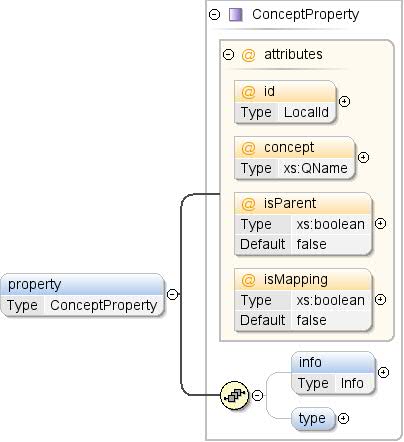 |
| Tipo |
ConceptProperty |
| Propriedades |
| content: |
complexo |
| minOcurs: |
0 |
| maxOccurs: |
ilimitada |
|
| Modelo |
info{0,1} , tipo{0,1} |
| Filhos |
info, tipo |
| Instância |
<property concept="" id="" isMapping="false" isParent="false">
<info>{0,1}</info>
<type ref="">{0,1}</type>
</property>
|
| Atributos |
| QName |
Tipo |
Fixo |
Padrão |
Usar |
Nota |
| Conceito |
xs:QName |
|
|
opcional |
Uma referência a um conceito que corresponde aos valores
da propriedade. Se a propriedade especificar um tipo, então o tipo
precisa corresponder ao tipo do conceito referenciado. Uma referência a um
conceito externo precisa ter a forma
"prefix:other_concept_id", em que "prefix" é
o prefixo usado para o namespace do conjunto de dados externo (consulte XML
namespaces). |
| id |
LocalId |
|
|
opcional |
O ID da propriedade de conceito. Esse identificador precisa ser
exclusivos dentro do conceito (em atributos e propriedades). A
id pode ser omitido se a propriedade conceitual for especificada. Nesse
caso, um ID é criado implicitamente com um valor igual ao nome local do
conceito referenciado. Por exemplo, <property
concept="geo:country"/> é equivalente a <property
id="country"
concept="geo:country"/> |
| isMapping |
xs:boolean |
|
falso |
opcional |
Se for verdadeiro, esta propriedade precisa fazer referência a um conceito, e
esta propriedade indica uma relação (1 para 1) de mapeamento entre
e o conceito referenciado. Cada instância do
é referenciado por no máximo uma instância deste
conceito. |
| isParent |
xs:boolean |
|
falso |
opcional |
Se for verdadeiro, esta propriedade precisa fazer referência a um conceito, e
essa propriedade indica uma relação hierárquica entre esta
e o conceito referenciado (por exemplo, o continente de um
país). |
|
| Origem |
<xs:element name="property" type="ConceptProperty" minOccurs="0" maxOccurs="unbounded">
<xs:annotation>
<xs:documentation>A property of the concept. Properties represent additional
information about instances of the concept (e.g., a concept
"city" may have a property "country").</xs:documentation>
</xs:annotation>
</xs:element>
|
Elemento: conceito / defaultValue
| Namespace |
http://schemas.google.com/dspl/2010 |
| Anotações |
Um valor padrão para o conceito, a ser usado por aplicativos
quando precisam escolher um dos valores possíveis do
conceito. |
| Diagrama |
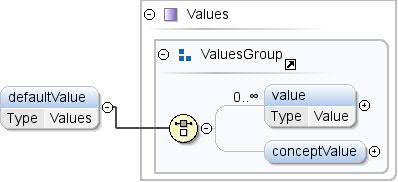 |
| Tipo |
Valores |
| Propriedades |
| content: |
complexo |
| minOcurs: |
0 |
|
| Modelo |
valor* | conceptValue{0,1} |
| Filhos |
conceptValue e value. |
| Instância |
<defaultValue>
<value lang="">{0,unbounded}</value>
<conceptValue concept="">{0,1}</conceptValue>
</defaultValue>
|
| Origem |
<xs:element name="defaultValue" type="Values" minOccurs="0">
<xs:annotation>
<xs:documentation>A default value for the concept, to be used by
applications when they need to pick one of the possible
values of the concept.</xs:documentation>
</xs:annotation>
</xs:element>
|
Elemento: conceito / tabela
| Namespace |
http://schemas.google.com/dspl/2010 |
| Anotações |
Uma referência a uma tabela que contém todos os valores possíveis.
para o conceito e as propriedades não constantes dele. |
| Diagrama |
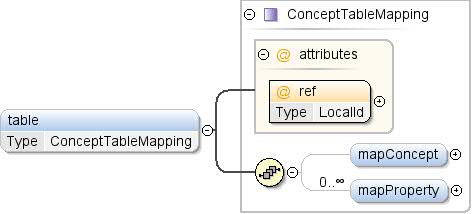 |
| Tipo |
ConceptTableMapping |
| Propriedades |
| content: |
complexo |
| minOcurs: |
0 |
|
| Modelo |
mapConcept{0,1} , mapProperty* |
| Filhos |
mapConcept e mapProperty |
| Instância |
<table ref="">
<mapConcept toColumn="">{0,1}</mapConcept>
<mapProperty lang="" ref="" toColumn="">{0,unbounded}</mapProperty>
</table>
|
| Atributos |
| QName |
Tipo |
Fixo |
Padrão |
Usar |
Nota |
| ref |
LocalId |
|
|
obrigatório |
O ID da tabela que contém dados para o
conceito. |
|
| Origem |
<xs:element name="table" type="ConceptTableMapping" minOccurs="0">
<xs:annotation>
<xs:documentation>A reference to a table that contains all the
possible values for the concept and its non-constant
properties.</xs:documentation>
</xs:annotation>
</xs:element>
|
Tipo complexo: conceito
| Namespace |
http://schemas.google.com/dspl/2010 |
| Anotações |
Um conceito é a definição de um tipo de dados que aparece
conjunto de dados (por exemplo, "PIB" ou "Condado"). Um conceito pode ser
associado a uma enumeração de todos os valores possíveis; Um
definido em algum conjunto de dados pode ser referenciado em outros
conjuntos de dados. |
| Diagrama |
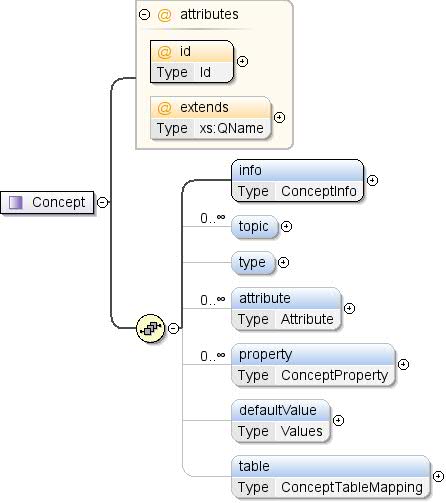 |
| Usados por |
|
| Modelo |
info , topic* , type{0,1} ,
atributo* , propriedade* , defaultValue{0,1} , tabela{0,1} |
| Filhos |
attribute, defaultValue, info,
propriedade, tabela, tópico,
tipo |
| Atributos |
| QName |
Tipo |
Fixo |
Padrão |
Usar |
Nota |
| estende |
xs:QName |
|
|
opcional |
O identificador exclusivo de um conceito que este conceito
se estende. O conceito mencionado pode ser definido no mesmo conjunto de dados
ou externamente, ou seja, em outro conjunto de dados. Uma referência a um objeto externo
conceito precisa ter o formato "prefixo:other_concept_id",
em que "prefixo" é o prefixo usado para o namespace do
o conjunto de dados externo (consulte Namespaces XML). |
| id |
ID |
|
|
obrigatório |
O identificador exclusivo do conceito, que deve ser
globalmente exclusivos dentro do conjunto de dados. |
|
| Origem |
<xs:complexType name="Concept">
<xs:annotation>
<xs:documentation>A concept is a definition of a type of data that appears in the
dataset (e.g., "GDP" or "County"). A concept may be associated with
an enumeration of all its possible values or not. A concept defined in
some dataset may be referenced in other datasets.</xs:documentation>
</xs:annotation>
<xs:sequence>
<xs:element name="info" type="ConceptInfo">
<xs:annotation>
<xs:documentation>Textual information, such as the name and description of
the concept.</xs:documentation>
</xs:annotation>
</xs:element>
<xs:element name="topic" minOccurs="0" maxOccurs="unbounded">
<xs:annotation>
<xs:documentation>A topic the concept is associated with.</xs:documentation>
</xs:annotation>
<xs:complexType>
<xs:attribute name="ref" type="xs:QName">
<xs:annotation>
<xs:documentation>The unique identifier of the topic this concept is
associated with.
The referenced topic may be defined in the same
dataset or externally, i.e., in another dataset. A
reference to an external topic must be of the form
"prefix:other_topic_id", where "prefix" is the prefix
used for the namespace of the external dataset (see
XML namespaces).</xs:documentation>
</xs:annotation>
</xs:attribute>
</xs:complexType>
</xs:element>
<xs:element name="type" minOccurs="0">
<xs:annotation>
<xs:documentation>The data type of the concept. A concept must provide a type declaration or extend
another concept. In the case where it's extending a concept, it may also
provide a type declaration. The type of the extended concept must be less restrictive
than the type of the concept extending it.
"Less restrictive than" (LRT) is a partial order defined as follows:
string LRT float
float LRT integer
string LRT date
string LRT boolean</xs:documentation>
</xs:annotation>
<xs:complexType>
<xs:attribute name="ref" type="DataType" use="required"/>
</xs:complexType>
</xs:element>
<xs:element name="attribute" type="Attribute" minOccurs="0" maxOccurs="unbounded">
<xs:annotation>
<xs:documentation>An attribute of the concept. Attributes represent additional
information about the concept (e.g., GDP is a percentage).</xs:documentation>
</xs:annotation>
</xs:element>
<xs:element name="property" type="ConceptProperty" minOccurs="0" maxOccurs="unbounded">
<xs:annotation>
<xs:documentation>A property of the concept. Properties represent additional
information about instances of the concept (e.g., a concept
"city" may have a property "country").</xs:documentation>
</xs:annotation>
</xs:element>
<xs:element name="defaultValue" type="Values" minOccurs="0">
<xs:annotation>
<xs:documentation>A default value for the concept, to be used by
applications when they need to pick one of the possible
values of the concept.</xs:documentation>
</xs:annotation>
</xs:element>
<xs:element name="table" type="ConceptTableMapping" minOccurs="0">
<xs:annotation>
<xs:documentation>A reference to a table that contains all the
possible values for the concept and its non-constant
properties.</xs:documentation>
</xs:annotation>
</xs:element>
</xs:sequence>
<xs:attribute name="id" type="Id" use="required">
<xs:annotation>
<xs:documentation>The unique identifier of the concept, which must be globally
unique within the dataset.</xs:documentation>
</xs:annotation>
</xs:attribute>
<xs:attribute name="extends" type="xs:QName" use="optional">
<xs:annotation>
<xs:documentation>The unique identifier of a concept that this
concept extends.
The referenced concept may be defined in the same
dataset or externally, i.e., in another dataset. A
reference to an external concept must be of the form
"prefix:other_concept_id", where "prefix" is the
prefix used for the namespace of the external
dataset (see XML namespaces).</xs:documentation>
</xs:annotation>
</xs:attribute>
</xs:complexType>
|
| Namespace |
Nenhum namespace |
| Anotações |
O identificador exclusivo do tópico a que este conceito está associado
com O tópico mencionado pode ser definido no mesmo conjunto de dados ou
externamente, ou seja, em outro conjunto de dados. Uma referência a um tópico externo
precisam estar no formato "prefix:other_topic_id",
"prefixo" é o prefixo usado para o namespace do namespace
conjunto de dados (consulte Namespaces XML). |
| Tipo |
xs:QName |
| Propriedades |
|
| Usados por |
|
| Origem |
<xs:attribute name="ref" type="xs:QName">
<xs:annotation>
<xs:documentation>The unique identifier of the topic this concept is
associated with.
The referenced topic may be defined in the same
dataset or externally, i.e., in another dataset. A
reference to an external topic must be of the form
"prefix:other_topic_id", where "prefix" is the prefix
used for the namespace of the external dataset (see
XML namespaces).</xs:documentation>
</xs:annotation>
</xs:attribute>
|
| Namespace |
Nenhum namespace |
| Tipo |
DataType |
| Propriedades |
|
| Atributos |
| enumeração |
string |
|
| enumeração |
float |
|
| enumeração |
número inteiro |
|
| enumeração |
booleano |
|
| enumeração |
data |
|
| enumeração |
conceito |
|
|
| Usados por |
|
| Origem |
<xs:attribute name="ref" type="DataType" use="required"/>
|
| Namespace |
Nenhum namespace |
| Anotações |
O identificador exclusivo do conceito, que precisa ser globalmente
exclusivos dentro do conjunto de dados. |
| Tipo |
ID |
| Propriedades |
|
| Atributos |
|
| Usados por |
|
| Origem |
<xs:attribute name="id" type="Id" use="required">
<xs:annotation>
<xs:documentation>The unique identifier of the concept, which must be globally
unique within the dataset.</xs:documentation>
</xs:annotation>
</xs:attribute>
|
Atributo: Conceito / @extends
| Namespace |
Nenhum namespace |
| Anotações |
O identificador exclusivo de um conceito estendido por esse conceito.
O conceito mencionado pode ser definido no mesmo conjunto de dados ou externamente,
ou seja, em outro conjunto de dados. Uma referência a um conceito externo deve ser
o formato "prefix:other_concept_id", em que "prefix" é
o prefixo usado para o namespace do conjunto de dados externo (consulte XML
namespaces). |
| Tipo |
xs:QName |
| Propriedades |
|
| Usados por |
|
| Origem |
<xs:attribute name="extends" type="xs:QName" use="optional">
<xs:annotation>
<xs:documentation>The unique identifier of a concept that this
concept extends.
The referenced concept may be defined in the same
dataset or externally, i.e., in another dataset. A
reference to an external concept must be of the form
"prefix:other_concept_id", where "prefix" is the
prefix used for the namespace of the external
dataset (see XML namespaces).</xs:documentation>
</xs:annotation>
</xs:attribute>
|
Criado usando o
Editor XML oXygen.
Exceto em caso de indicação contrária, o conteúdo desta página é licenciado de acordo com a Licença de atribuição 4.0 do Creative Commons, e as amostras de código são licenciadas de acordo com a Licença Apache 2.0. Para mais detalhes, consulte as políticas do site do Google Developers. Java é uma marca registrada da Oracle e/ou afiliadas.
Última atualização 2025-07-25 UTC.
[[["Fácil de entender","easyToUnderstand","thumb-up"],["Meu problema foi resolvido","solvedMyProblem","thumb-up"],["Outro","otherUp","thumb-up"]],[["Não contém as informações de que eu preciso","missingTheInformationINeed","thumb-down"],["Muito complicado / etapas demais","tooComplicatedTooManySteps","thumb-down"],["Desatualizado","outOfDate","thumb-down"],["Problema na tradução","translationIssue","thumb-down"],["Problema com as amostras / o código","samplesCodeIssue","thumb-down"],["Outro","otherDown","thumb-down"]],["Última atualização 2025-07-25 UTC."],[],["Concepts, within a dataset (namespace: `http://schemas.google.com/dspl/2010`), define data types and are globally unique. Concepts can extend others, using `prefix:other_concept_id` for external references. They include `info` (textual details), `topic` (associated topics via `ref`), `type` (data type, `ref`), `attribute` (additional information), `property` (instance information), `defaultValue`, and `table` (data source, `ref`). Key concept attributes are `id` (unique), and `extends` (referencing another concept). External references are in `prefix:identifier` format. A concept must have a `type` or `extends`.\n"]]








